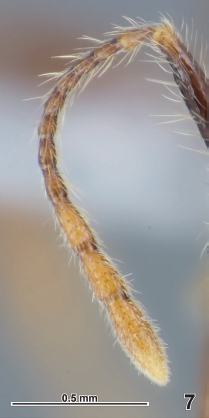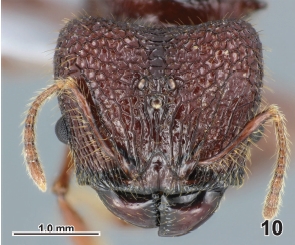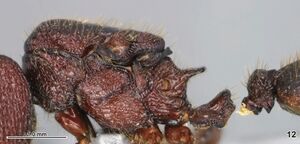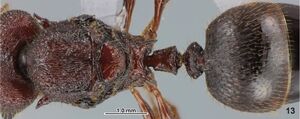Pheidole leloi
| Pheidole leloi | |
|---|---|

| |
| Scientific classification | |
| Kingdom: | Animalia |
| Phylum: | Arthropoda |
| Class: | Insecta |
| Order: | Hymenoptera |
| Family: | Formicidae |
| Subfamily: | Myrmicinae |
| Tribe: | Attini |
| Genus: | Pheidole |
| Species group: | quadricuspis |
| Species: | P. leloi |
| Binomial name | |
| Pheidole leloi Eguchi & Bui, 2016 | |
The type series (a single colony) was collected from rotten wood on the forest floor of a relatively disturbed patch of an evergreen forest at an altitude of ca. 1,000 m.
Identification
Eguchi et al. (2016) - In the major, vertex as well as dorsal, lateral and ventrolateral faces of vertexal lobe strongly and coarsely reticulate; promesonotal dome with an inconspicuous transverse ridge on its posterior slope; pronotal spine almost straight; posterior slope and lateral face of the dome, mesopleuron and metapleuron irregularly rugoso-reticulate; propodeal spine somewhat digitiform, with blunt apex; ventral face of petiole with a conspicuous longitudinal carina; anterior half to two thirds of first gastral tergite finely rugoso-punctate. In the minor, posterior part of frons and vertex reticulate; mesosoma relatively densely covered with standing hairs; dorsal face of promesonotal dome weakly punctured, overlain with several rugae, and lateral face of the dome, mesopleuron, metapleuron and dorsal face of propodeum punctate; propodeal spine in lateral view elongate-triangular; petiolar node in lateral view acute at apex, and in posterior view widely and shallowly emarginate at apex.
These features well distinguish P. leloi from Pheidole quadricuspis and its named allies.
Distribution
Distribution based on Regional Taxon Lists
Oriental Region: Vietnam (type locality).
Distribution based on AntMaps
Distribution based on AntWeb specimens
Check data from AntWeb
Countries Occupied
| Number of countries occupied by this species based on AntWiki Regional Taxon Lists. In general, fewer countries occupied indicates a narrower range, while more countries indicates a more widespread species. |

|
Estimated Abundance
| Relative abundance based on number of AntMaps records per species (this species within the purple bar). Fewer records (to the left) indicates a less abundant/encountered species while more records (to the right) indicates more abundant/encountered species. |

|
Biology
Eguchi et al. (2016) - Pheidole leloi has so far been collected just once from an evergreen forest located in the Da Lat Plateau’s eastern edge despite our long-term intensive surveys in various localities of Vietnam (Eguchi, 2008, 2011). In contrast with southern Vietnam under the subtropical climate with relatively distinct dry season, along the Da Lat Plateau’s eastern edge annual rainfall reaches 3,850 mm and there is essentially no dry season (Sterling et al., 2006). This suggests that P. leloi, as well as Pheidole quadricuspis and its allies (Eguchi, 2001), are adapted to humid wooded environments.
Castes
Worker
Minor
   
| |
| . | |
Major
 
| |
| . | |
Queen
   
| |
| . | |
Nomenclature
The following information is derived from Barry Bolton's Online Catalogue of the Ants of the World.
- leloi. Pheidole leloi Eguchi & Bui, in Eguchi, Bui et al., 2016: 47, figs. 1-13 (s.w.q.) VIETNAM.
Unless otherwise noted the text for the remainder of this section is reported from the publication that includes the original description.
Description
Worker
Major Holotype (major): HL, 2.36 mm; HW, 2.62 mm; SL, 1.22 mm; ML, 2.27 mm; PW, 1.18 mm; HFL 1.76 mm; PtL 0.58 mm; PtW 0.47 mm; PPtL 0.45 mm; PPtW 0.77 mm; CI, 111; SI, 46; MI, 193; HFI, 67; PtI1, 130; PtI2, 62. Paratype majors (n=8): HL, 2.39-2.49 mm, HW, 2.55-2.71 mm; SL, 1.18-1.24 mm; ML, 2.23-2.35 mm; PW, 1.16-1.20 mm; HFL, 1.74-1.80 mm; PtL, 0.61-0.67 mm; PtW, 0.46-0.52 mm; PPtL, 0.45-0.49 mm; PPtW, 0.77-0.86 mm; CI, 107-110; SI, 45-47; MI, 188-198; HFI, 65-68; PtI1, 128-145; PtI2, 60-63.
Body dark reddish brown with darker gaster, relatively densely covered with standing hairs. Head in full-face view subrectangular, with its posterior margin narrowly and shallowly emarginated medially, in lateral view relatively thick, faintly impressed on vertex; frons longitudinally rugoso-reticulate; vertex, and dorsal, lateral and ventrolateral faces of vertexal lobe strongly and coarsely reticulate; gena longitudinally rugose; frontal carina almost absent or present just as rugula(e); antennal scrobe absent; median portion of clypeus almost smooth or faintly rugose longitudinally, with a few longitudinal rugae laterally; median longitudinal carina of clypeus relatively distinct; hypostoma with a pair of stout submedian processes but without median process; lateral processes of hypostoma present but tiny; masticatory margin of mandible with apical and preapical teeth, and a tooth in front of basal angle; outer surface of mandible smooth except its base, scattering relatively long decumbent/appressed hairs; antenna with 3-segmented club; maximal diameter of eye longer than or almost as long as antennal segment X. Promesonotal dome with an inconspicuous transverse ridge on its posterior slope; pronotal spine long, slender, almost straight, with pointed apex; anterior slope of promesonotal dome largely smooth with several transverse rugae; posterior slope and lateral face of the dome, mesopleuron and metapleuron irregularly rugoso- reticulate; propodeum irregularly rugoso-reticulate dorsally, longitudinally rugose laterally, and transversely rugose posteriorly; propodeal spine somewhat digitiform, with blunt apex. Ventral surface of midcoxa and hindcoxa smooth. Petiole longer than postpetiole (excluding helcium); petiolar node in lateral view blunt at apex, in posterior view widely and shallowly emarginate at apex, in dorsal view laterally with a narrow flange; ventral face of petiole with a conspicuous longitudinal carina; postpetiole in dorsal view much broader than long, somewhat spindle-shaped; its anteroventral part forming a sharp transverse ridge. Anterior half to two thirds of first gastral tergite finely rugoso-punctate.
Minor HL, 0.97-1.01 mm, HW, 0.89-0.93 mm; SL, 1.21-1.27 mm; ML, 1.42-1.50 mm; PW, 0.61-0.65 mm; HFL, 1.36-1.43 mm; PtL, 0.31-0.34 mm; PtW, 0.14-0.16 mm; PPtL, 0.28-0.29 mm; PPtW, 0.31-0.34 mm; CI, 91-93; SI, 134-138; MI, 227-235; HFI, 152-155; PtI1, 111-119; PtI2, 45-49.
Body dark reddish brown, relatively densely covered with standing hairs. Anteromedian part of frons largely smooth; posterior part of frons and vertex reticulate; area between antennal insertion and eye, and gena rugose; preoccipital carina conspicuous dorsally and laterally; median portion of clypeus slightly punctate, with a median longitudinal carina; masticatory margin of mandible with apical and preapical teeth followed by several small teeth; 1 or 2 small denticles between the preapical tooth and 3rd tooth; outer surface of mandible longitudinally rugose, scattered with long decumbent hairs; antenna with 3-segmented club; scape extending far beyond posterolateral margin of head; maximal diameter of eye shorter than antennal segment X. Promesonotal dome with a pair of spines that are long, slender and pointed apically; posterior slope of the dome with an inconspicuous transverse ridge; dorsal face of the dome weakly punctate, overlain with several rugae; lateral face of the dome, mesopleuron, metapleuron and dorsal face of propodeum punctate; propodeal spine in lateral view elongate-triangular. Petiole a little longer than postpetiole (excluding helcium); petiolar node in lateral view acute at apex, and in posterior view widely and shallowly emarginate at apex; ventral face of petiole without any process and longitudinal carina.
Queen
HL, 2.10 mm, HW, 2.50 mm; SL, 1.21 mm; ML, 3.19 mm; MSW, 2.03 mm; HFL, 1.90 mm; PtL, 0.82 mm; PtW, 0.72 mm; PPtL, 0.60 mm; PPtW, 0.91 mm; CI, 119; SI, 48; MI, 157; HFI, 76; PtI1, 136; PtI2, 79.
Body dark reddish brown with darker gaster, relatively densely covered with standing hairs. Head in full-face view subtrapezoidal, with its posterior margin broadly and shallowly concave, in lateral view relatively thick, not impressed on vertex, with its posterior margin narrowly and shallowly emarginated medially; frons longitudinally rugoso-reticulate; vertex, and dorsal, lateral and ventrolateral faces of vertexal lobe strongly and coarsely reticulate; gena longitudinally rugose; frontal carina present just as rugula(e); antennal scrobe absent; median portion of clypeus faintly rugose longitudinally, with a few longitudinal rugae laterally; median longitudinal carina of clypeus relatively conspicuous; hypostoma with a pair of stout submedian processes but without median process; lateral processes of hypostoma present but tiny; masticatory margin of mandible with apical and preapical teeth, and a tooth in front of basal angle; outer surface of mandible smooth except its base, scattered with relatively long decumbent to appressed hairs; antenna with 3-segmented club; maxi mal diameter of eye longer than or almost as long as antennal segment X; median ocellus in full-face view located a little behind the level of the posterior margin of compound eye; maximum diameter of median ocellus a little longer than the distance between the median and lateral ocelli. Mesosoma fully segmented; pronotum almost smooth anteriorly and reticulate laterally; pronotal spine stout and straight, directing anterolaterad; mesoscutum longitudinally rugose medially and irregularly rugoso-reticulate laterally; parapsidal line weakly recognized; scuto-scutellar suture present as a deep and broad impression; mesoscutellum largely smooth dorsally; mesopleuron irregularly rugoso-reticulate, subdivided into anepisternum and katepisternum; metapleuron irregularly rugoso-reticulate; propodeum longitudinally rugose laterally, and transversely rugose posteriorly; propodeal spine somewhat digitiform, with blunt apex. Ventral surface of midcoxa and hindcoxa smooth. Petiole longer than postpetiole (excluding helcium); petiolar node in lateral view blunt at apex, in posterior view widely and shallowly emarginate at apex, in dorsal view laterally with a narrow flange; ventral face of petiole with a conspicuous longitudinal carina; postpetiole in dorsal view much broader than long, somewhat spindle-shaped; its anteroventral part forming a sharp transverse ridge. Anterior three fifths of first gastral tergite finely rugoso-punctate.
Type Material
Vietnam National Museum of Nature; holotype (major); Vietnam, Khanh Hoa, Hon Ba Nature Reserve, 12°07’24”-38”N, 108°58’24”-28”E, ca. 1030-1050 m alt.; K. Eguchi leg.; 16/iii/2013 [colony: Eg16iii13-24]. — VNMN, Museum of Comparative Zoology, Musee d'Histoire Naturelle Genève, Katsuyuki Eguchi; paratypes; 8 majors, 9 minors, 1 queen from the same colony as holotype; Accession No. LC020537; voucher specimen No. Ext20130410-1 (paratype) from the same colony as holotype (ACEG).

